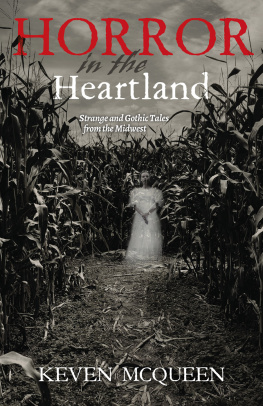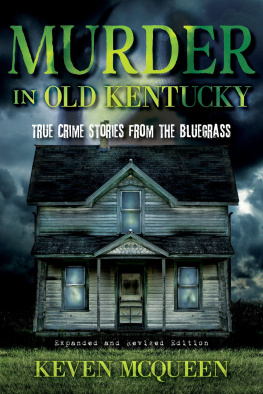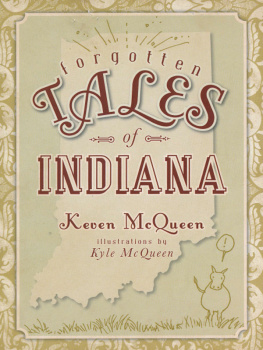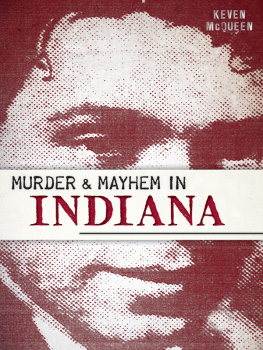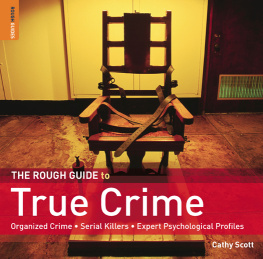This book is a publication of
Quarry Books
an imprint of
INDIANA UNIVERSITY PRESS
Office of Scholarly Publishing
Herman B Wells Library 350
1320 East 10th Street
Bloomington, Indiana 47405 USA
iupress.org
2021 by Keven McQueen
All rights reserved
No part of this book may be reproduced or utilized in any form or by any means, electronic or mechanical, including photocopying and recording, or by any information storage and retrieval system, without permission in writing from the publisher. The paper used in this publication meets the minimum requirements of the American National Standard for Information SciencesPermanence of Paper for Printed Library Materials, ANSI Z39.48-1992.
Manufactured in the United States of America
First printing 2021
Cataloging information is available from the Library of Congress.
ISBN 978-0-253-05844-7 (paperback)
ISBN 978-0-253-05845-4 (ebook)
CONTENTS
A CKNOWLEDGMENTS
M URDEROUS M ISSOURI
M ICHIGAN M AYHEM
I LL -T EMPERED I LLINOIS
N AUGHTY N EBRASKA
C RIMINAL K ANSAS
M INNESOTA M ASSACRES
I OWA E XTERMINATIONS
I NDIANA I MBROGLIOS
O HIO O BLITERATIONS
W ASTED IN W ISCONSIN
B IBLIOGRAPHY
EASTERN KENTUCKY UNIVERSITY DEPARTMENT OF ENGLISH; EASTERN Kentucky University Interlibrary Loan Department (Stefanie Brooks and Heather Frith); Chris Flook, President of the Delaware County [IN] Historical Society; Daniel Allen Hearn; Jeffrey, Denise, and Amber Hughes; Dave Hulsey, Lesley Bolton, Rachel Erin Rosolina, Carol McGillivray, Anna C. Francis, and everyone at the Indiana University Press; Amy Hawkins McQueen and Quentin Hawkins; Darrell and Swecia McQueen; Darren, Alison, and Elizabeth McQueen; Kyle McQueen; Michael, Lori, and Blaine McQueen and Evan Holbrook; Craig and Debbie Smith; and Mia Temple.
MURDEROUS ACTS
The Maxwell Trunk Murder
There is no guarantee of lasting fame for poets, novelists, artistsor murderers. Some infamous slayings remain in the public consciousness decades after their commission, and some dont. Everyone is familiar with Jack the Rippers dark deeds, yet probably not one person in a hundred thousand has ever heard of the contemporaneous Maxwell Trunk Murder even though it was the subject of much excited talk from our great-great-grandfathers. Jack the Ripper, whoever he was, made the cut (so to speak) and attained criminal immortality; Maxwell did not. This is his story.
On March 30, 1885, a twenty-five-year-old girlish-looking, blonde young man checked into the Southern Hotel in St. Louis, Missouri. Claiming to be from London, as well as a doctor and a nobleman, he signed the guest register with the imposing name Walter Henry Lennox Maxwell, and the duly impressed staff gave him room 144. A few days later, the hotel received a telegram from another Englishman, wealthy merchant Charles Arthur Preller, asking if Maxwell was registered there. The staff replied that he was. On April 3, twenty-nine-year-old Preller showed up and checked into room 184.
The hotel staff noted that Maxwells manner was very effeminate, which he even carried so far as to walk with short, mincing steps like a woman. A witness later described Preller as being of a retiring, almost effeminate nature. The staff also observed that both Maxwell and Preller seemed dude-ish and dandified, not unlike Oscar Wilde, and spent a lot of time together in Prellers room. The staff jumped to the (then) obvious conclusion: Maxwell and Preller must be good friends and old acquaintances.
On April 6, Maxwell disappeared from the hotel. He had paid a weeks rent in advance, so it was several days before the staff realized he was not returning. Meanwhile, an unappetizing reek was coming from Maxwells room, which gained strength and pungency with each day. Upon inspecting room 144, the staff found that the source of the smell was a zinc trunk Maxwell had left behind. Porters, bellhops, and the like had learned through hard experience to be wary of foul-smelling trunks. On April 14, the hotel staff forced open the small trunk and found the ripe corpse of a man folded inside, clad only in pants, tongue protruding, and skin black with decomposition. He had a cross cut into his chest, and his head had been severed to make for easier packaging. The killer had written a mysterious message and pasted it on an inside wall of the trunk, right behind the victims head: So perish all traitors to the great cause. An artist for the St. Louis Post-Dispatch held his nose with one hand and, with the other, sketched the open trunk and its contents. The drawing was widely reprinted in the nations papers and undoubtedly caused many readers to gag on their breakfast of oatmeal and marmalade. The trunk was hustled off to the morgue, but the smell lingered in the hotel corridor long after it was gone.
A second trunk of Maxwells contained only papers, likely to the relief of the Post-Dispatchs artist. Seven trunks belonging to Preller were found in Prellers room, containing passports for Russia, Spain, and Mexico and hundreds of dollars worth of clothes, tapestries, and rugs, which suggested that Preller had been much wealthier than Maxwell.
It was the coroners solemn duty to determine whether the less-than-spruce man in the trunk was Preller. The corpse had dark hair and eyes, revealing it to be Preller rather than the blue-eyed, blond Maxwell. The killer had shaved Prellers handsome moustache, perhaps to make identification of the body slightly (very slightly) more difficult. A chemist detected chloroform in the body. It appeared that Maxwell had waited until Preller was asleep and then held a cloth saturated with the powerful anesthetic under his victims nose until death overtook him.
The wounds on Prellers body were postmortem, made during his killers spirited attempt to cram the corpse into the tiny trunk. Maxwell likely intended to smuggle the chest out of the hotel but panicked and fled, leaving behind not only the body but also his own personal items and bushel baskets of incriminating evidence, including prescription forms showing that a few days before he disappeared, he had visited a St. Louis druggist, J. A. Fernow, who told detectives he had sold Maxwell six ounces of chloroform. A partly filled bottle of the drug was found among the fugitives abandoned possessions. At the inquest held on April 18, a salesperson positively identified Maxwell as the customer who, on April 6, had purchased the trunk that housed Prellers body.
As the investigation unfolded, little pieces of the false identity Maxwell had created for himself were stripped away. He turned out to be neither a doctor nor a baronet, but rather a struggling solicitor and the son of a schoolmaster in Hyde, England. On June 10, it was ascertained that his real name was Hugh Mottram Brooks, so from this point he shall be called that rather than Maxwell in the narrative. Brooks had a girlfriend named Whitaker back in Hyde, whom the locals considered much too good for him, as they felt Brooks was a fool and a neer-do-well. A couple of months before the murder, Brooks had turned up in Chicago so dead broke, as he put it, that he offered to write for a newspaper to make money to pay his hotel bill. But a witness who saw Brooks on a train heading west the day after he fled St. Louis noticed that the formerly indigent Englishman somehow had attained plenty of cash.


